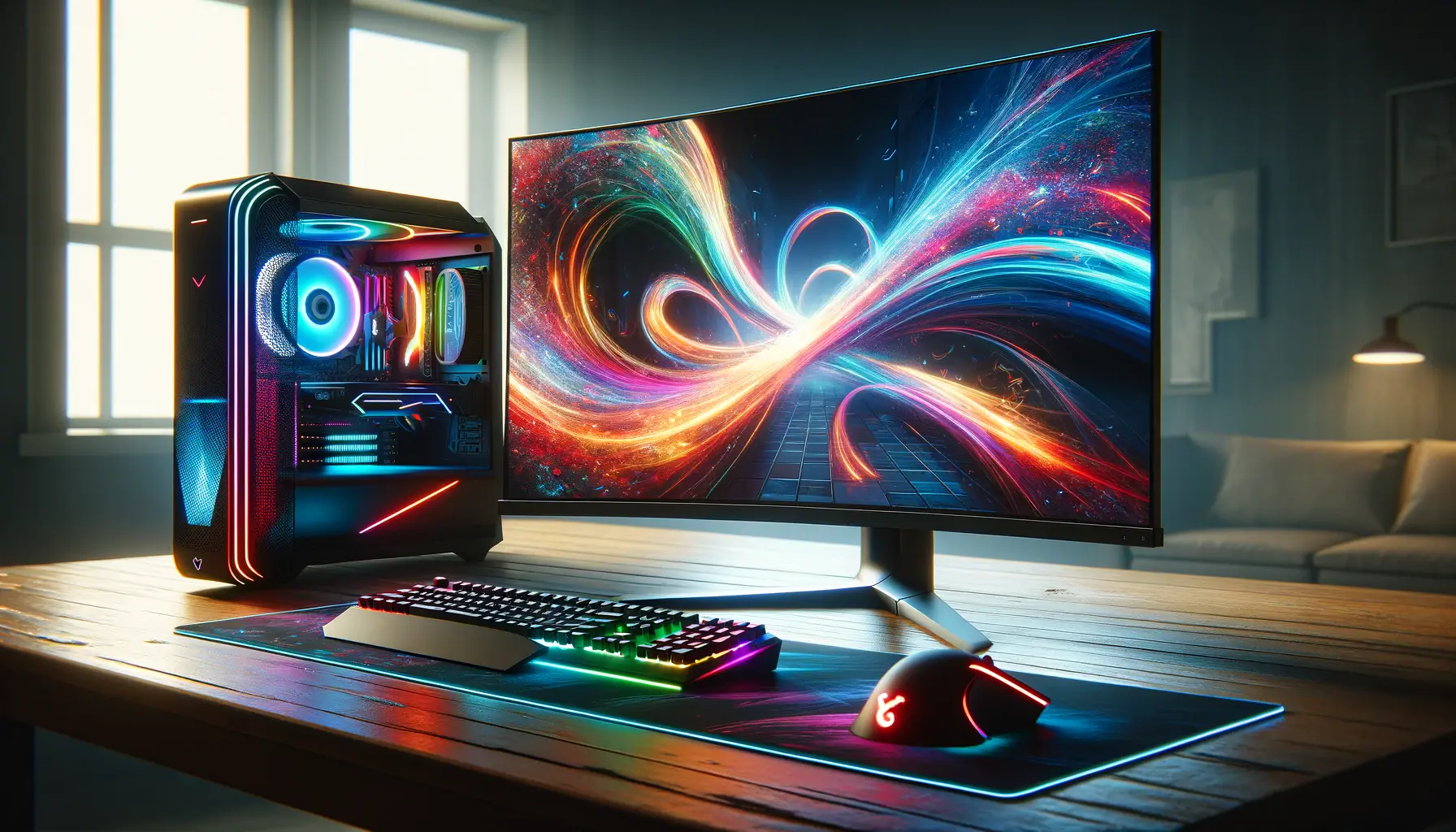The gaming landscape is ever-evolving, with technological advancements pushing the boundaries of what’s possible in virtual worlds.
Among these innovations, NVIDIA’s Deep Learning Super Sampling (DLSS) technology stands out, particularly its latest iteration, DLSS 3.
This cutting-edge feature promises to revolutionize gaming visuals and performance, leveraging artificial intelligence to enhance image quality and boost frame rates.
But what do gamers think?
This article delves deep into the world of DLSS 3, exploring its impact on gaming experiences from the perspective of those who matter most: the players.
DLSS 3, introduced alongside NVIDIA’s RTX 40 series graphics cards, is not just an incremental update but a significant leap forward.
By intelligently generating frames, it aims to deliver smoother gameplay and sharper images, even in the most demanding titles.
The technology’s promise is to allow gamers to enjoy their favorite games at higher resolutions and settings without compromising performance.
But beyond the technical jargon and marketing hype, the real question remains: does DLSS 3 live up to gamers’ expectations?
Through a comprehensive analysis of user experiences and performance reviews, we aim to uncover the truth behind DLSS 3’s impact on the gaming community.
- DLSS 3 Technology
- DLSS 3 in Action: Game Performance Insights
- Gamer Feedback and Community Reactions
- DLSS 3 vs. Traditional Rendering Techniques
- Optimizing Settings for DLSS 3
- Future of Gaming with DLSS 3
- Exploring DLSS 3’s Impact on Game Development
- Embracing the Future with DLSS 3
- DLSS 3 Reviews: Essential FAQs
DLSS 3 Technology
What is DLSS and How Does It Work?
At its core, DLSS (Deep Learning Super Sampling) is NVIDIA’s AI-driven rendering technology designed to increase graphical performance without sacrificing quality.
By utilizing dedicated AI processors on RTX GPUs, known as Tensor Cores, DLSS analyzes each game frame and intelligently generates high-quality images.
DLSS 3, the latest version, introduces frame generation alongside image upscaling, promising to redefine gaming smoothness and visual fidelity.
DLSS 3’s magic lies in its ability to produce additional frames, filling in the gaps between existing ones to create a smoother gaming experience.
This process, known as frame generation, works in tandem with the AI upscaling to not only maintain but often enhance the visual quality of games.
The result is a significant boost in frame rates, making games look and feel better, especially on 4K displays where performance gains are most notable.
The Evolution of DLSS
The journey from DLSS 1.0 to DLSS 3.0 is a tale of continuous improvement and innovation.
Initial versions of DLSS faced criticism for image quality issues and limited game support.
However, NVIDIA took this feedback to heart, making substantial strides with each new iteration.
DLSS 2.0 marked a significant improvement, offering greater flexibility and quality options.
Now, DLSS 3 not only enhances resolution but also introduces AI-generated frames, setting a new standard for game rendering technologies.
DLSS 3’s introduction alongside NVIDIA’s RTX 40 series GPUs showcases the company’s commitment to pushing the boundaries of gaming technology.
By leveraging the power of AI, DLSS 3 offers a glimpse into the future of gaming, where performance and quality coexist without compromise.
This evolution reflects NVIDIA’s dedication to enhancing the gaming experience, making the most advanced titles accessible to a broader audience without the need for prohibitively expensive hardware upgrades.
DLSS 3 represents a significant leap in gaming technology, combining AI-driven image upscaling with frame generation to deliver unparalleled performance and visual quality.
DLSS 3 in Action: Game Performance Insights
The true test of DLSS 3’s effectiveness lies in its real-world application across various games.
Gamers and reviewers alike have put DLSS 3 through its paces, reporting on its impact on game performance and visual quality.
This section dives into these insights, offering a clearer picture of how DLSS 3 transforms gaming experiences.
Performance improvements with DLSS 3 vary from game to game, but the consensus points to significant gains, especially in titles that are traditionally resource-intensive.
Here are some key observations:
- Frame Rate Increases: One of the most touted benefits of DLSS 3 is its ability to dramatically boost frame rates. Games that struggled to maintain smooth performance at higher resolutions have seen remarkable improvements, with some titles reporting up to a 2x increase in FPS.
- Enhanced Visuals: Despite the primary focus on performance, DLSS 3 also contributes to sharper and more detailed visuals. The AI upscaling ensures that even when games are rendered at lower resolutions, the final image quality rivals or exceeds native high-resolution output.
- Reduced Latency: DLSS 3’s frame generation technology not only makes games run smoother but also helps reduce input lag. This is particularly beneficial in fast-paced games where every millisecond counts.
Comparative Analysis Across Titles
To better understand DLSS 3’s impact, it’s helpful to look at specific examples.
Games like “Cyberpunk 2077,” “Control,” and “Death Stranding” have all benefited from DLSS 3, showcasing noticeable improvements in both performance and visual fidelity.
“Cyberpunk 2077,” for instance, saw a jump from sub-30 FPS to stable 60 FPS at 4K with DLSS 3 enabled, without compromising on the game’s stunning visual details.
Another aspect worth noting is the technology’s scalability.
DLSS 3 scales effectively across different hardware, offering significant benefits to users with varying GPU capabilities.
This scalability ensures that a wide range of gamers can experience enhanced performance and visuals, regardless of their system’s power.
The transformative effect of DLSS 3 on game performance and visuals underscores NVIDIA’s leadership in gaming innovation, setting new benchmarks for what gamers can expect from future technologies.
Gamer Feedback and Community Reactions
The introduction of DLSS 3 has sparked a wide range of reactions from the gaming community, from enthusiastic praise to cautious optimism.
Gathering feedback from various forums, social media platforms, and gaming reviews offers a comprehensive view of how gamers perceive this new technology.
Many gamers have expressed amazement at the performance gains DLSS 3 brings to their favorite titles.
The ability to play graphically demanding games at higher resolutions and settings without suffering performance hits has been a game-changer for many.
However, there are also voices of concern, particularly regarding the technology’s accessibility and compatibility with older hardware.
- Positive Reactions:
- Improved Frame Rates: Gamers appreciate the significant FPS improvements, which enhance the smoothness and playability of games.
- Visual Quality: The consensus is that DLSS 3 successfully boosts visual fidelity, making games look better without the usual performance cost.
- Reduced Latency: The reduction in input lag has been particularly praised by players of competitive and fast-paced games.
- Critical Feedback:
- Hardware Requirements: Some gamers express disappointment over DLSS 3’s exclusivity to the latest NVIDIA GPUs, limiting its accessibility.
- Game Support: The limited number of titles currently supporting DLSS 3 has been a point of contention, with calls for broader implementation.
- Artifacts and Glitches: A minority report occasional artifacts or glitches, particularly in scenes with complex motion or lighting.
Community Discussions and Debates
Online gaming forums and social media are abuzz with discussions about DLSS 3.
Enthusiasts debate its merits, sharing before-and-after screenshots and videos to highlight the differences.
These platforms have become valuable resources for gamers curious about DLSS 3, offering a wealth of user-generated content and experiences.
Despite the varied opinions, one thing is clear: DLSS 3 has made a significant impact on the gaming community.
It has set a new standard for performance and visual quality, prompting discussions about the future of gaming technology.
As more games adopt DLSS 3, its full potential and long-term implications will become even clearer.
The gaming community’s engagement with DLSS 3 reflects a broader interest in the future of gaming technology, highlighting the importance of continuous innovation in the field.
DLSS 3 vs. Traditional Rendering Techniques
Comparing DLSS 3 with traditional rendering techniques sheds light on the technological leaps NVIDIA has made with its latest offering.
Traditional rendering, including techniques like rasterization and ray tracing, has set the foundation for video game graphics.
However, these methods often require significant computational power, especially at higher resolutions and settings.
DLSS 3 revolutionizes this landscape by integrating AI-driven frame generation and super-resolution.
This not only enhances performance but also maintains, if not improves, image quality.
The comparison between DLSS 3 and traditional methods highlights the balance DLSS 3 strikes between performance and visual fidelity.
- Rasterization: This traditional rendering technique converts 3D objects into a 2D image but can struggle with complex scenes or high resolutions. DLSS 3, by contrast, allows for higher resolutions without the same performance penalty.
- Ray Tracing: Known for its realistic lighting and reflections, ray tracing is computationally intensive. DLSS 3 complements ray tracing by boosting frame rates, making it more feasible to use in real-time gaming.
- Anti-Aliasing Techniques: Methods like MSAA and FXAA improve image quality by smoothing out edges but can impact performance. DLSS 3 includes its own anti-aliasing as part of the upscaling process, enhancing image quality without the usual drawbacks.
Performance and Quality Trade-offs
The introduction of DLSS 3 has sparked discussions about the trade-offs between performance and image quality.
Traditional rendering techniques often force gamers to choose between the two, especially in demanding titles.
DLSS 3’s technology aims to eliminate this compromise, offering both high performance and quality.
Through its AI-driven approach, DLSS 3 analyzes and reconstructs images in a way that mimics the detail and clarity of higher resolutions.
This not only results in smoother gameplay but also in visuals that can rival or surpass those produced by traditional methods.
The ability of DLSS 3 to dynamically adjust to the demands of different games and scenes further underscores its advantage over conventional rendering techniques.
DLSS 3 represents a paradigm shift in gaming graphics, challenging the status quo of traditional rendering methods and setting a new benchmark for performance and quality.
Optimizing Settings for DLSS 3
Maximizing the benefits of DLSS 3 involves fine-tuning game settings and understanding how DLSS interacts with other graphical options.
While DLSS 3 significantly enhances performance and visual quality, the right settings can elevate the gaming experience even further.
This section explores tips for optimizing game settings to fully leverage DLSS 3’s capabilities.
DLSS 3’s performance is influenced by various factors, including resolution, in-game graphical settings, and the specific characteristics of each game.
Here are some guidelines to help gamers get the most out of DLSS 3:
- Resolution Considerations: DLSS 3 is most effective at higher resolutions, such as 1440p and 4K. Gamers aiming for the best balance of performance and visual fidelity should target these resolutions.
- Graphical Settings: While DLSS 3 allows for higher settings without compromising frame rates, finding the sweet spot for each game’s graphical options can enhance the overall experience. Experimenting with settings like shadows, textures, and effects while monitoring performance can help identify the optimal configuration.
- Frame Generation: DLSS 3’s frame generation feature is a game-changer for smoothness but can be adjusted based on personal preference. Some gamers might prefer to disable it in favor of pure upscaling for certain titles or scenarios.
Advanced Configuration Tips
Beyond basic settings adjustments, advanced configuration can unlock further improvements.
NVIDIA’s control panel and in-game DLSS options offer additional tweaks that can fine-tune performance and quality:
- Adjusting the DLSS mode from ‘Quality’ to ‘Performance’ or ‘Ultra Performance’ can impact the balance between image quality and frame rate. Gamers should choose based on their priority: maximum detail or the smoothest possible gameplay.
- Enabling NVIDIA Reflex in games that support it can reduce latency further, enhancing responsiveness, especially in fast-paced titles.
- Monitoring GPU and CPU usage can help identify bottlenecks. In some cases, adjusting settings to balance the load between the CPU and GPU can yield better overall performance.
By carefully adjusting settings and understanding how DLSS 3 interacts with other graphical options, gamers can achieve an unparalleled gaming experience.
The key is to experiment and find the right balance for each individual game and hardware setup.
Optimizing game settings for DLSS 3 not only enhances performance and visual quality but also ensures a tailored gaming experience that meets individual preferences and hardware capabilities.
Future of Gaming with DLSS 3
The advent of DLSS 3 marks a significant milestone in the evolution of gaming technology, offering a glimpse into the future of how games will be played and experienced.
Its impact extends beyond just the immediate improvements in frame rates and image quality, hinting at a new era where AI and deep learning play central roles in game development and execution.
As we look ahead, the potential applications and advancements of DLSS-like technologies could redefine gaming in several key areas:
- Wider Adoption Across Games: As DLSS 3 demonstrates its value, more developers are likely to integrate this technology into their titles, expanding its benefits across a broader range of games and genres.
- Integration with Next-Gen Hardware: Future generations of GPUs will likely build on the foundation laid by NVIDIA’s RTX series, further optimizing DLSS technology and potentially introducing new AI-driven features.
- Enhancements in VR and AR: The performance and visual quality improvements offered by DLSS 3 could significantly benefit virtual and augmented reality experiences, making them more immersive and accessible.
Challenges and Opportunities
Despite the promising outlook, the journey ahead for DLSS 3 and similar technologies will not be without challenges.
Ensuring broad compatibility with a range of hardware, maintaining a balance between AI-generated and traditional content, and addressing any emerging issues with image quality or game dynamics will be critical for widespread acceptance.
However, these challenges also present opportunities for innovation.
The gaming industry’s response to DLSS 3 could spur further research and development in AI and machine learning, leading to even more sophisticated rendering techniques and gameplay enhancements.
The dialogue between developers, hardware manufacturers, and the gaming community will be instrumental in shaping the future of gaming technology.
The potential for DLSS 3 to influence game design itself is also significant.
With the constraints of hardware performance lessened, developers might explore new creative directions, crafting experiences that were previously unfeasible due to technical limitations.
This could lead to a renaissance in game design, where creativity is only bounded by imagination, not hardware.
The future of gaming with DLSS 3 promises not only technological advancements but also a shift in the creative landscape of game development, opening new horizons for what games can achieve and offer to players.
Exploring DLSS 3’s Impact on Game Development
The introduction of DLSS 3 is not just a win for gamers in terms of enhanced performance and visuals; it also represents a significant shift in game development paradigms.
Developers now have at their disposal a powerful tool that can dramatically alter the way games are designed, developed, and delivered.
DLSS 3’s influence on game development can be seen in several key areas:
- Performance Optimization: With DLSS 3, developers can push the boundaries of graphical fidelity and complex game mechanics without as much concern for the performance limitations of current hardware. This opens up new possibilities for creating more immersive and visually stunning game worlds.
- Resource Allocation: The efficiency gains from DLSS 3 allow development teams to reallocate resources that would have been spent on performance optimization to other areas, such as story development, game mechanics, or even exploring new game concepts.
- Accessibility: By making high-end graphics more accessible to players without top-of-the-line hardware, DLSS 3 democratizes the gaming experience, potentially expanding the market for more graphically demanding games.
Revolutionizing Game Design
DLSS 3’s impact extends beyond the technical aspects of game development to influence game design itself.
Developers are now empowered to envision game environments and dynamics that were previously impractical, knowing that DLSS 3 can help deliver these experiences to a broad audience without compromising performance.
This technology also encourages innovation in genres that are traditionally more graphically conservative due to performance concerns.
For example, large-scale open-world games, intricate simulation games, and highly detailed strategy games can all benefit from the enhanced capabilities DLSS 3 offers, leading to richer, more complex game experiences.
As DLSS 3 and similar technologies evolve, the game development community will likely see a shift in how games are conceptualized from the ground up.
The traditional constraints of balancing visual fidelity with performance are being redefined, allowing for a new era of game development where the focus can shift more towards innovation and creativity.
DLSS 3 not only enhances the gaming experience for players but also serves as a catalyst for change in game development, encouraging a new wave of creativity and innovation in the industry.
Embracing the Future with DLSS 3
The journey through the realms of DLSS 3 technology, its impact on gaming performance, visual fidelity, and the broader implications for game development and design, underscores a pivotal shift in the digital entertainment landscape.
NVIDIA’s DLSS 3 not only represents a significant technological advancement but also heralds a new era for gamers and developers alike, characterized by boundless possibilities and the promise of ever-more immersive gaming experiences.
The Gamers’ Perspective
From the gamers’ viewpoint, DLSS 3 has been a game-changer.
The ability to enjoy their favorite titles at higher resolutions and settings without compromising on performance has been nothing short of revolutionary.
The technology has effectively bridged the gap between desire for high-quality visuals and the need for smooth, responsive gameplay.
As more titles adopt DLSS 3, players can look forward to a future where the visual and performance limitations of yesterday’s games are but a distant memory.
Implications for Game Development
For developers, DLSS 3 opens up new horizons in game design and development.
Freed from the constraints of hardware limitations, creative teams can now explore new concepts and push the boundaries of what’s possible in a virtual world.
This technology not only optimizes resources but also democratizes high-end gaming, making it accessible to a wider audience.
The ripple effects of DLSS 3 on game development are profound, promising a future where the focus shifts from overcoming technical limitations to unleashing creativity and innovation.
- Performance Optimization: DLSS 3 allows for the creation of more detailed and expansive game worlds without the fear of performance drops.
- Resource Allocation: Development teams can redirect their efforts from technical optimization to enhancing gameplay and narrative elements.
- Accessibility: By making graphically intensive games playable on a wider range of hardware, DLSS 3 expands the potential market for new and innovative titles.
In conclusion, DLSS 3 is not just a technological marvel; it’s a catalyst for change in the gaming industry.
It challenges the status quo, pushing the envelope of what’s possible in digital entertainment.
As we stand on the brink of this new era, the excitement for what’s to come is palpable.
The fusion of AI and gaming has opened the door to a world where the only limits are those of the imagination.
For gamers and developers alike, the future is bright, and it’s powered by DLSS 3.
DLSS 3 Reviews: Essential FAQs
As DLSS 3 reshapes the gaming landscape, numerous questions arise regarding its functionality, benefits, and requirements. Here are the answers to some of the most frequently asked questions, providing clarity and insight into this groundbreaking technology.
DLSS 3 is NVIDIA’s latest AI-driven rendering technology, enhancing game performance and visual quality by intelligently generating frames and upscaling images.
DLSS 3 boosts frame rates by generating additional frames and upscaling images, resulting in smoother gameplay without sacrificing visual fidelity.
Yes, DLSS 3 includes NVIDIA Reflex technology, which significantly reduces gaming latency, enhancing responsiveness in fast-paced games.
No, DLSS 3 is supported exclusively on GeForce RTX 40 Series GPUs, leveraging their advanced AI capabilities for frame generation.
Not all games currently support DLSS 3. Its adoption depends on developers integrating the technology into their titles.
DLSS 3 enhances visual quality by upscaling lower-resolution images to higher fidelity, making games look sharper and more detailed.
DLSS 3 is designed for RTX 40 Series GPUs and is not backward compatible with older RTX models due to its advanced AI processing requirements.
DLSS 3 promises to significantly enhance VR gaming by improving performance and visual clarity, making VR experiences more immersive.












